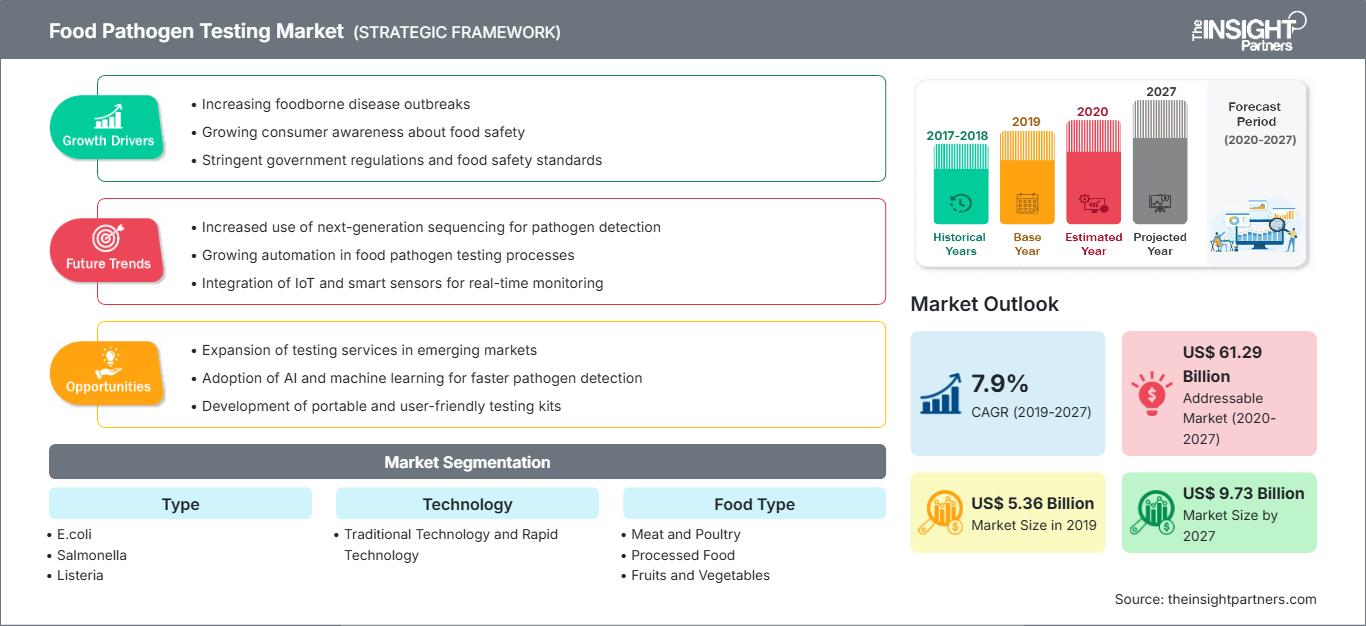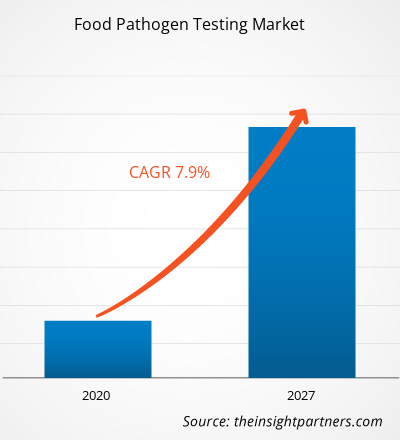食品病原体検査市場は2019年に53億6,094万米ドルと評価され、2027年までに97億3,191万米ドルに達すると予測されています。また、2020年から2027年にかけて7.9%のCAGRで成長すると見込まれています。
食品病原体検査は、食品中の生命を脅かす細菌や微生物の存在を監視するのに役立つプロセスと定義されています。有害な食中毒につながる可能性のある病原体を引き起こすウイルスや細菌が約31種類知られているため、食品病原体検査は主に食品業界にとって重要です。この検査方法は、食品の安全性を確保するために、食品生産のあらゆる段階で採用されています。食中毒の件数の増加による安全上の懸念と規制の増加は、食品病原体検査市場の成長を促進しています。また、ポリメラーゼ連鎖反応(PCR)や免疫磁気分離法といった様々な食品病原体検査法の進歩、そして検出時間の短縮は、食品業界の様々な企業による食品病原体検査の導入を促進しています。
ヨーロッパの食品病原体検査市場は、予測期間中に最も高いCAGRで成長すると予想されています。この地域の市場成長の主な要因は、食中毒の発生率の上昇とそれに伴う食品安全に対する意識の高まりが、北米における食品病原体検査の需要を押し上げていることです。ナノバイオテクノロジーと相まって、病原体検査法の発展も市場の成長を支えています。医療費の増加と、食品・飲料業界における遺伝子組み換え生物の活用も、市場の成長を後押ししています。食品貿易のグローバル化と経済発展は、この地域における食品病原体検査市場の拡大に貢献しています。消費者と食品メーカーの間で食品病原体検査導入のメリットに対する意識が高まっていることは、食品病原体検査市場の発展にとって大きなチャンスをもたらしています。
要件に合わせてレポートをカスタマイズ
レポートの一部、国レベルの分析、Excelデータパックなどを含め、スタートアップ&大学向けに特別オファーや割引もご利用いただけます(無償)
食品病原体検査市場: 戦略的洞察

-
このレポートの主要な市場動向を入手してください。この無料サンプルには、市場動向から見積もりや予測に至るまでのデータ分析が含まれます。
COVID-19の流行は、ロックダウン、渡航禁止、事業閉鎖により、様々な国の経済や産業に悪影響を及ぼしています。食品・飲料は、サプライチェーンの制限や生産工場の閉鎖など、深刻な混乱に見舞われている主要産業の一つです。各国の様々な工場やプラントの閉鎖は、世界のサプライチェーンを混乱させ、製造活動、納期、様々な商品の販売に悪影響を及ぼしています。様々な企業が既に、製品の納品遅延や今後の販売低迷の可能性を発表しています。さらに、ヨーロッパ、アジア、北米の国々による世界的な渡航禁止は、ビジネスコラボレーションやパートナーシップの機会を妨げています。したがって、これらの要因は、食品および飲料業界における食品病原体検査市場の成長を抑制しています。
市場洞察:乳製品生産における迅速な病原体検査の増加が、食品病原体検査市場の成長を促進すると予想される
食品病原体検査技術は、食品安全技術の進化に伴い、継続的に強化され、採用されています。今日の乳製品生産者は、製品、施設、ワークフローのさまざまなカテゴリに適した、正確で迅速な病原体検査のために、さまざまなオプションを選択できます。迅速な食品病原体検査技術は、最も効果的かつ効率的な方法で標的の病原体を検出する目的で、さまざまな化学に基づいています。酵素結合蛍光アッセイ(ELFA)ベースの技術は、病原体の特定の細胞表面受容体を標的にして識別を行います。ポリメラーゼ連鎖反応(PCR)に基づく技術は、各病原体内部のDNAを標的とします。
乳製品工場における迅速検査技術の導入には、結果を得るまでの時間が短縮されるなど多くの利点があります。これにより、生産効率の向上、保管時間の短縮、製品の賞味期限の延長といった目的のために、検査項目の絞り込みや検査回数の削減が可能になります。また、迅速検査技術の活用は有害事象への対応を迅速化し、乳製品生産施設は必要な是正措置を講じることで、廃棄や腐敗による損失を防ぐことができます。さらに、これらの迅速な食品病原体検査法は使いやすく、作業員の柔軟性を高めることができます。ほとんどの乳製品メーカーは社内検査プログラムを導入しています。適切なトレーニングと適切な機器の入手性があれば、高度な微生物学の学位は、病原体検査プログラムの成功を妨げるものではなくなります。さらに、迅速検査法の入手性と費用対効果の向上により、乳製品メーカーはデータを社内で管理し、サンプルと結果のトレーサビリティと管理を強化することができます。データの活用と保管は、メーカーが分析を活用し、サプライチェーンから生産ライン、保管施設に至るまで、積極的な意思決定を行うのに役立ちます。迅速な病原体検査の利点により、乳製品メーカーはそれを製造ユニットに導入しており、それが食品病原体検査市場の成長を促進しています。
タイプ別インサイト
食品病原体検査市場は、タイプ別にブランチング済みとナチュラルの2つに分かれています。サルモネラ菌セグメントは2018年に大きな市場シェアを占め、予測期間中に市場でより高いCAGRを記録すると予想されています。サルモネラ菌は、人体の腸管に影響を与える最も一般的な細菌性疾患です。下痢、腹部のけいれん、発熱を引き起こします。これは主に、生または加熱不十分な肉、鶏肉、卵製品の摂取によって引き起こされます。サルモネラ菌感染症は、特に乳幼児、女性、成人の免疫システムを弱めます。時には命に関わることもあるため、食品病原体検査は主にサルモネラ菌に対して行われます。サルモネラ菌に感染するリスクは非常に高く、人は簡単に感染します。そのため、この感染と人命の損失を防ぐために、食品病原体検査はこの分野で非常に重要な役割を果たし、食品病原体検査市場の成長を促進します。
食品タイプの洞察
食品タイプに基づいて、食品病原体検査市場は、肉と鶏肉、乳製品、加工食品、果物と野菜、穀物と穀類に分類されます。肉と鶏肉セグメントは2018年に最大の市場シェアを占めました。タンパク質摂取量の向上や屋外での夕食への支出の増加など、健康上の利点により、世界の肉の消費量が大幅に増加しています。消費者の意識と健康意識の高まりにより、製品の品質を向上または維持する必要性から、食品病原体検査の需要が高まっています。家禽、肉、魚介類を介した食品病原体発生の増加に起因する規制の策定は、セグメントの成長を増幅させます。肉と家禽に関連する最も重要な病原体は、大腸菌、カンピロバクター、サルモネラ菌です。皮剥ぎや羽毛除去中の不衛生な状況や不適切な取り扱いは、このセグメントの成長を支える汚染につながると予想されます。
テクノロジーインサイト
技術に基づいて、食品病原体検査市場は、従来型技術と迅速型技術に分類されます。迅速型技術セグメントは2018年に最大の市場シェアを占めました。従来型技術に関連する簡単な手順と低い初期コストが、このセグメントの成長を支えています。コストの削減や精度の向上など、さまざまな利点があり、このセグメントの成長を促進する可能性があります。従来型技術は非常に正確ですが、病原体検出にかなりの時間がかかります。場合によっては数日から数週間かかります。さらに、食品微生物学研究所は過去30年間で大きく変化しました。 1980年代初頭には、品質管理試験に重点が置かれ、これはメーカーが社内で行っていました。しかし、業界が食品安全管理にHACCPアプローチを導入し始めると、品質管理は品質保証に取って代わられました。食品安全管理の目標は検出ではなく予防となり、残りの微生物学的試験の多くは外部委託されました。従来の技術では、検出に十分な細胞を得るために、サンプル中の微生物を培養することに頼っていました。この培養工程には少なくとも24時間かかり、病原体によっては5日以上かかることもあります。従来の方法では、HACCPシステムの重要管理点を効果的に監視するのに十分な速さで結果を提供することができず、現在は主にシステムが正しく機能していることを確認するために使用されています。
食品病原体検査市場で活動している企業としては、SGS SA、Bureau Veritas、Intertek Group Plc、Eurofins Scientific、Mérieux NutriSciences、ifp Institut für Produktqualität GmbH、ALS Limited、AsureQuality、Microbac Laboratories、FoodChain ID Group Incなどが挙げられます。主要企業は、合併や買収、研究開発戦略を実行することで顧客基盤を拡大し、世界市場で大きなシェアを獲得し、ブランド名を世界的に維持することにも取り組んでいます。
食品病原体検査市場
予測期間を通じて食品病原体検査市場に影響を与える地域的な傾向と要因については、The Insight Partnersのアナリストが詳細に解説しています。このセクションでは、北米、ヨーロッパ、アジア太平洋、中東・アフリカ、中南米における食品病原体検査市場のセグメントと地域についても解説しています。
食品病原体検査市場レポートの範囲
| レポート属性 | 詳細 |
|---|---|
| の市場規模 2019 | US$ 5.36 Billion |
| 市場規模別 2027 | US$ 9.73 Billion |
| 世界的なCAGR (2019 - 2027) | 7.9% |
| 過去データ | 2017-2018 |
| 予測期間 | 2020-2027 |
| 対象セグメント |
By 種類
|
| 対象地域と国 |
北米
|
| 市場リーダーと主要企業の概要 |
|
食品病原体検査市場のプレーヤー密度:ビジネスダイナミクスへの影響を理解する
食品病原体検査市場は、消費者の嗜好の変化、技術の進歩、製品の利点に対する認知度の高まりといった要因によるエンドユーザーの需要増加に牽引され、急速に成長しています。需要の増加に伴い、企業は提供内容の拡大、消費者ニーズへの対応のための革新、そして新たなトレンドの活用を進めており、これが市場の成長をさらに加速させています。

- 入手 食品病原体検査市場 主要プレーヤーの概要
- 食品病原体検査市場における進歩的な業界動向。企業が効果的な長期戦略を策定するのに役立ちます
- 先進国と発展途上国で採用されているビジネス成長戦略
- 2019年から2027年までの食品病原体検査市場の定量分析
- 食品病原体検査の世界的需要の予測
- 業界で事業を展開しているバイヤーとサプライヤーの有効性を示すPEST分析
- 競争の激しい市場シナリオを理解するための最近の動向
- 市場の動向と見通し、および食品病原体検査市場の成長を促進および抑制する要因
- 商業的関心を支え、市場の成長につながる市場戦略を強調することにより、意思決定プロセスを支援
- さまざまなノードにおける食品病原体検査市場の規模
- 市場の詳細な概要とセグメンテーション、および食品病原体検査業界のダイナミクス
- 2027年の食品病原体検査市場の規模有望な成長機会のあるさまざまな地域
食品病原体検査市場 - タイプ別
- 大腸菌
- サルモネラ菌
- リステリア菌
- カンピロバクター
- その他
食品病原体検査市場 - 技術別
- 従来型技術
- 迅速技術
食品病原体検査市場 - 技術別食品の種類別
- 肉類と鶏肉
- 乳製品
- 加工食品
- 果物と野菜
- 穀物
企業プロフィール
- SGS SA
- Bureau Veritas
- Intertek Group Plc
- Eurofins Scientific
- Mérieux NutriSciences.
- ifp Institut für Produktqualität GmbH
- ALS Limited
- AsureQuality
- Microbac Laboratories
- FoodChain ID Group Inc
- 過去2年間の分析、基準年、CAGRによる予測(7年間)
- PEST分析とSWOT分析
- 市場規模価値/数量 - 世界、地域、国
- 業界と競争環境
- Excel データセット
最新レポート
関連レポート
お客様の声
購入理由
- 情報に基づいた意思決定
- 市場動向の理解
- 競合分析
- 顧客インサイト
- 市場予測
- リスク軽減
- 戦略計画
- 投資の正当性
- 新興市場の特定
- マーケティング戦略の強化
- 業務効率の向上
- 規制動向への対応






















 無料サンプルを入手 - 食品病原体検査市場
無料サンプルを入手 - 食品病原体検査市場